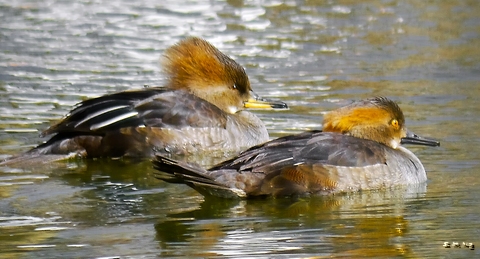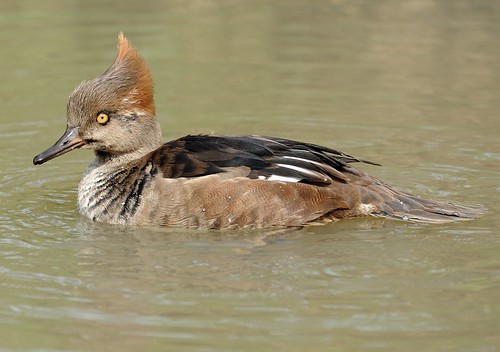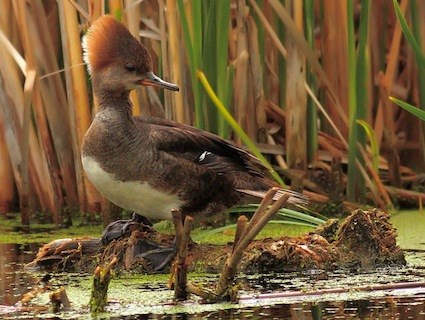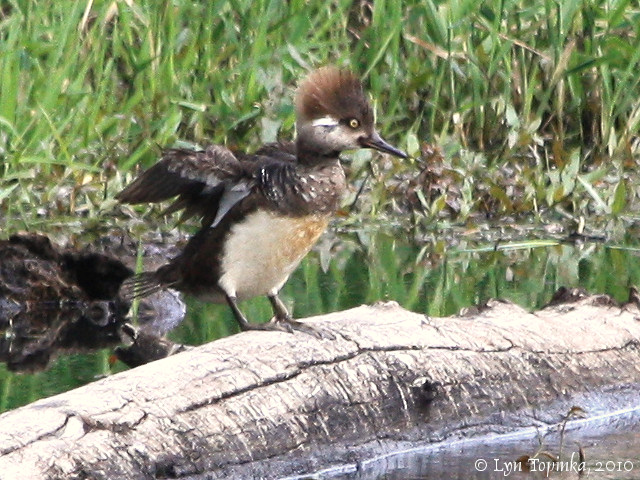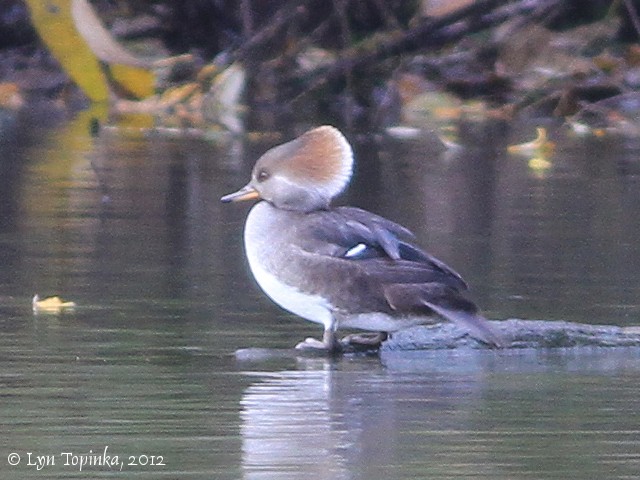6/8/2013 (Sat) full day
Clove Lake Park, Blue Heron Park, JBWR
camera: GH2 + 100-300mm
Periodical Cicadas, hundreds if not thousands. See a few in final
molt; a completely white teneral adult at a fence and a darkening
one at another fence near to it.
Blue Heron Park (office is closed probably because of heavy rain
yesterday): Mating
Blue Dashers & the female
lays her eggs immediately (see also SI trip on 5/29/2011)
JBWR: Osprey 2 juveniles & parent on the nest. Barn Swallow
and Tree Swallow(s) foraging over the water at Big John's Pond.
Juvenile/Immature Black-crowned Night Herons.
Blue Dasher.
Photo:
Periodical Cicada -
<1>
<2a>
<2b>
(marco)
<3>
(looking at me)
<4>
(at home)
<5>
(flying, a tree at
Royal Oak Road)
bugguide.net
<6a>
<6b>
<7>
Blue Dasher -
male-1 (using
flash)
mating-1 (shortUrl)
Song Sparrow
Barn Swallow and Tree Swallow (flying)
Glossy Ibis (flying)
Black-crowned Night Heron -
<1>
<2>
Catbird -
<1>
Video:
Osprey (2 juveniles
& parent)
蜻蜓點水
Note:
(1) 蜻蜓點水 -
就是蜻蜓產卵,卵直接產入水中,或產於水草上。卵孵化出來的稚蟲,稱為水蠆。水蠆常伸出勾狀帶爪鉤的下唇,捕捉水中小動物為生。水蠆是游泳專家,它採用的是噴射式的,只要
腹部一壓縮,水就往後噴,身體自然向前衝,速度極快。以直腸氣管鰓呼吸。水蠆長大了,爬上突出水面的樹枝或石頭,就羽化成一隻猶如空中飛龍的蜻蜓
成蟲了。 src good info mirror
(2)
URL Shorteners: Which Shortening Service Should You Use?
(3) Surging in numbers that outdo predator gluttony is not some
special cicada thing, Karban notes. Mayflies "hatching" from their
aquatic to aerial forms synchronize, as fly fishing enthusiasts
know. Oak trees drop occasional bumper crops of acorns. But cicadas,
much louder than acorns, get the headlines.
... figuring out the right year is a puzzle. They could "count" the
years with seasonal changes in the tree sap they feed on, Karban
speculates, and he has tested this idea by trying to fool them. He
dug up cicadas with two years yet to go underground and moved them
onto the roots in a colleague’s research plot of peach trees. The
colleague coaxed the trees to fruit twice in one year, and cicadas
emerged as if two years had passed instead of one.
src
保育黑琵台灣獲國際獎 鳥界籲高層出席 (2013.06.04
03:00 am)
全文網址: 保
育黑琵我獲國際獎 鳥界籲高層出席 | 綜合 | 國內要聞 | 聯合新聞網 http://udn.com/NEWS/NATIONAL/NAT5/7941421.shtml#ixzz2VDJbBplp
6/1/2013 (Sat) am hot & sunny
Kissena
camera: GH2 + 100-300mm
Baltimore Oriole couple. Many dragonflies and damselflies at the
baseball field of Rose Ave.
Photo:
Baltimore Oriole, male -
<1>
5/27/2013 (Mon) pm sunny
Staten Island - Clove Lakes Park (1150
Clove Rd, Staten Island, NY 10301),
Great Kills Park (188 Buffalo St, Staten Island, NY 10306), 77 Woodland Ave, Staten Island, NY 10308,
& Lemon Creek Park)
camera: GH2 + 100-300mm
Clove Lakes Park: Spotted Sandpiper in
beautiful breeding plumage
Great Kills Park: Oystercatcher, Grackles, Gulls. Dragonflies.
Lemon Creek Park: male Purple Martin, female of course. And
Starling. Dragonfly.
Photo:
Spotted Sandpiper - <1>
<2>
<3>
Purple Martin - female-1
male-1
male-2
both-1 both-2
both-3
Video:
Spotted Sandpiper
Purple Martin
Note:
(1) Parking - Clove Lakes
Park, at Lake Club or outside Clove Rd.
(2) Great Kills Park: part of the Staten Island unit of
Gateway National Recreation Area
(3) map: Great
Kills Park (188 Buffalo St, Staten Island, NY 10306) & 77
Woodland Ave, Staten Island, NY 10308
5/25/2013 (Sat) pm cold, windy (morning 45F; forecast windy up to
40mph)
Kissena
camera: GH2 + 100-300mm
Red-tailed Hawk baby seen and shot.
Canada Goose goslings (2) with their parents and the ("guarded")
old Goose. I call it a wonderful goose family of 5! A small
rabbit.
Photo:
Red-tailed Hawk baby
 -
<1>
-
<1>
5/18/2013 (Sat) am cloudy
JBWR / Kissena
camera: GH2 + 100-300mm
Not much in JBWR. Brown Thrasher (1) singing energetically on the
tree top. Canada Goose goslings are
many here and Kissena Park too. Towhee. The male & female
Tree Swallows (photoed on 4/27) are still at the branch doing
nothing; waiting for warmer weather?
Kissena: meet Henry Yee's family.
Photo:
Rose-breasted Grosbeak - <1>
Canada
Goose gosling - <1>
<2>
<3a>
<3b>
Tree
Swallow -
Robin - <1>
<2>
Is it Seaside Rose (Rosa
rugosa)? P1420867.JPG
/ RW2 cf.
this one at Oceanside
5/16/2013 (Thu) early morning before going to work (about
6:45-7:30am)
Kissena Corridor
Probably Baltimore Oriole, an immature & a female. Pheasant.
Red-tailed Hawk, baby?
5/12/2013 (Sun) pm
Kissena
camera: GH2 + 100-300mm
Photo:
Mourning Dove -
Red-tailed Hawk - <1>
<2>
Starling - <1a>
<1b>
(OOC jpg)
5/11/2013 (Sat) pm
Kissena
camera: GH2 + 100-300mm
Photo:
Catbird -
Pheasant -
5/4/2013 (Sat) am
Kissena
camera: GH2 + 100-300mm
A 1 inch damselfly, male Eastern
Forktail, and a bigger (about 1.5 inch) brown damselfly, possibly a
female Bluet or dancer or even a dragonfly? Cowbirds (male only).
Pheasants, males and 1 female. The female Red-tailed Hawk is still
sitting on the nest, probably still incubating. No sight of the
male. Heard Woodpecker drumming.
Photo:
Eastern Forktail - <1a>
<1b>
<2> <3>
Small Cabbage White
(Pieris
rapae)
butterfly - <1>
<2>
Cardinal - <1>
<2>
4/28/2013 (Sun) pm
Kissena
camera: GH2 + 100-300mm
Photo:
Blue Jay - <1>
4/27/2013 (Sat) 9-11:30am / pm after Dim Sum
JBWR / Kissena
camera: GH2 + 100-300mm
In Kissena Park, two
Double-crested Cormorants swim together very closely and both
showing breeding plumage and the 2 crests. They are probably
couple. A male Pheasant is scared by me and flies to Corridor Park.
Photo:
European Paper Wasp (Polistes dominula) - <1>
(cf.
http://bugguide.net/node/view/200209)
Mallard - <1>
<2>
Tree Swallow - <1a>
(spreading wings)
<1b> (facebk) <2>
<3>
(雌
雄–燕–同株) <4>
a brown/red wasp - <1>
(the same one taken on 9/10/2011 by FZ35?) -
probably Northern Paper Wasp (Polistes
fuscatus)
Song Sparrow -
House Sparrow -
Note:
Northern Paper Wasp (Polistes
fuscatus) can be black in color:
http://bugguide.net/node/view/123793 and wiki
4/14/2013 (Sun)
Kissena
camera: GH2 + 100-300mm
Photo:
4/13/2013 (Sat)
Kissena
camera: GH2 + 100-300mm
Photo:
Cardinal - <1>
3/29/2013 (Fri) - 4/9/2013 (Tue)
New Orleans / Norwegian Star 7-night cruise
camera: GH2 / Canon ELPH
log01_NewOrleans.txt myPic
Album:
Google+
Picasa
2013WinterTrip.doc Roatan
Tips from BoddenTours birds_in_new_orleans.htm
Note:
19 Mar 2010 visited Cozumel, Mexico
Photo found on Web:
Audubon Zoo birds
Audubon Park Bird Island mysteriously abandoned
3/23/2013 (Sat) pm, sunny & cold
Westchester
camera: GH2 + 100-300mm
Hawk (or Vulture?).
Photo:
Woodpecker
Nuthatch - <1>
3/17/2013 (Sun) after church lunch, cloudy (sun barely seen behind
cloud for short time) & cold
Kissena Corridor Park
camera: GH2 + 100-300mm
Red-tailed Hawk first seen
perching at a tree in the park near the nest; flying into the ground
of community garden; then back to nest with a stick/twig (still
building the nest), where his mate (female larger than male) is
already there. Inside the blueberry shrub (灌
木) is probably a Mockingbirds' nest. Dark-eyed Juncos. Many
sharp pictures of Robins &
Mockingbird.
Photo:
Robin - <1>
Red-tailed Hawk - <1>
Mockingbird - <1>
House Sparrow - <1>
Video:
Red-tailed Hawk
Mockingbird
Info: Red-tailed Hawk (Buteo
jamaicensis) 1
Video found on Web:
Red-tailed hawks nesting at 185 Alewife in Cambridge, Mass.
3/16/2013 (Sat) morning, cloudy & cold
Kissena Corridor Park / Kissena Park
camera: GH2 + 100-300mm
Red-tailed Hawk's nest empty. No
Common Merganser or Hooded Merganser. Grackle. Dark-eyed
Juncos. Ring-billed Gulls still here.
Photo:
Robin
Dark-eyed Junco - <1>
Red-bellied Woodpecker - <1>
Grackle
Subject: Common Merganser at Kissena Park [src]
Date: Wed Mar 13 2013 22:47 pm
From: czar3233 AT yahoo.com
[Cesar Castillo]
I was out this afternoon hoping to spot a Phoebe, but looks like
Brooklyn got to it first (Spring officially begins?)
I found one female Common Merganser amongst the Mallards, Shovelers,
Canada Geese, and Ring-billed Gulls. Also a few female Hooded
Mergansers.
On the topic of signs of Spring, I also noticed some Red Maples were
in full bloom, not just unopened buds and on my failed attempt on
Sat to find the Varied Thrush I came across a patch of flowering
Winter Aconite. I have also noticed some Moths flying around in
Alley Pond Park around sunset.
3/9/2013 (Sat) morning & afternoon, beautiful sunny
Kissena Corridor Park / Kissena Park
camera: GH2 + 100-300mm
Red-tailed Hawk nests at
East-West School of International Studies / Rachel Carson
Intermediate School 237 (46-21
Colden Street, Flushing, NY 11355). One
(probably the same one but possibly another one - his or her mate)
was watched for quite a long time standing at a tree inside
Corridor Park.
Spring has been here with many Robins; and I saw a butterfly, a
fly, a
mature Small Milkweed Bug (same location found Boxelder Bug in Fall
2011/Winter 2012) and some very small insects. Cardinals and
RWBBs are singing.
Hooded Mergansers. Northern
Shovelers (still a lot).
Photo:
Robin - <1>
Ring-billed Gull -
Northern Shoveler - <1a>
(cropped)
<1b>
<2a>
<2b>
(w2673) P1360777.JPG/RW2
Red-tailed Hawk -
IS237:
<1a>
<1b>
(cropped) <2>
flight: <1>
tree in Corridor Park: <1>
Red-winged Blackbird - <1>
Starling - <1>
Small Milkweed Bug -
<1>
Squirrel -
Video:
Red-tailed Hawk
Note on Small Milkweed Bug (Lygaeus kalmii):
(1)
Adults suck nectar from flowers of various herbaceous plants, and
also feed on milkweed seeds(?). Also reported to be scavengers and
predators, especially in spring when milkweed seeds are scarce.
They have been reported feeding on honey bees, monarch
caterpillars and pupae, and dogbane beetles, among others. The
Life of a Californian Population of the Facultative Milkweed Bug Lygaeus kalmii
(from bugguide.net)
(2) The adults of the spring generation undertake dispersal
flights during the late morning and afternoon on sunny days. (pdf)
Note on Red-tailed
Hawk:
(1) Comparison
of Adult & Immature tails
(2) Unlike some other raptors, the Red-tailed Hawk are
seemingly unfazed by considerable human activity and can nest and
live in close proximity to large numbers of humans.[4] Thus,
the species can also be found in cities, where common prey such as rock pigeons and brown rats may
support their populations.[16] One
urban Red-tailed Hawk, known as "Pale
Male", became famous for being the first Red-tail in decades
to successfully nest and raise young in the crowded New York
City borough of Manhattan.[17]
3/2/2013 (Sat) morning, cloudy
Kissena Park / East-West School of International Studies
camera: GH2 + 100-300mm
在那天下無雙的女人協助下,鄙人捕捉到牠展開雙翅起飛的瞬間.
女人的可怕,連小鷗也知道!
Hooded Mergansers. Northern
Shovelers (still a lot).
Photo:
Ring-billed Gull -
<1>
(wing up before flight)
Mallard - <1>
(wing spread) <2>
Mockingbird - <1a>
(look innocent, probably 1st year)
<1b>
(w1600)
2/24/2013 (Sun) afternoon, cloudy
Kissena Park
camera: GH2 + 100-300mm
Ring-billed Gulls (only a few). Hooded
Mergansers (2 females, immature?).
Northern Shoveler (still a lot)
Photo:
American Black Duck -
<1>
Mallard - <1>
2/10/2013 (Sun) afternoon, sunny, temperature around freezing point
Kissena Park
camera: GH2 + 100-300mm
Icy Pond. Ring-billed Gulls and Mallards fight for feeding food.
Photo:
Mallard -
<1>
<2>
American Black Duck -
<1>
(female; not Mallard because of its metallic violet
wing patch not edged with white) <2>
metallic
violet wing patch not edged with white
Cardinal -
Woodpecker -
Song Sparrow -
2/8/2013 (Fri) waiting for winter storm Nemo to come
Blizzard Warning remains in effect until 1 pm EST Saturday.
-
Locations: New York City, Southern Westchester County, and coastal
portions of Northeast New Jersey.
-
Hazard types: Heavy snow and strong winds.
-
Accumulations: snow accumulation of 10 to 14 inches, with
localized higher amounts within intense snow bands.
-
Winds: north 15 to 25 mph with gusts up to 45 mph.
-
Temperatures: in the upper 20s by this evening.
-
Visibilities: one quarter mile or less at times.
-
Timing: The strongest winds and heaviest snow will occur this
evening into Saturday morning.
-
Impacts: Heavy snow and winds will make for dangerous driving
conditions with visibilities near zero in White-out conditions. In
addition, some tree limbs will be downed. Causing scattered power
outages.
1993 2 28 (Sun) I arrived at NYC
1993 3 13 (Fri) Blizzard of '93 hits north-east US. More on 1993
Storm of the Century. Snowfall at New York, NY (LaGuardia):
12.3 in (31 cm) . I moved stuffs to my new rented studio apartment
in the evening before the hit of the heavy snow.
Now, after 20 years living at the urban jungle, ...
Statistics:
snowiest month
in New York City
- (1) February 2010, 36.9 inches; (2) January 2011, 36.0 inches;
(3) January 1925, 27.4 inches.
Winter Storm 'Nemo': A Historical Perspective -
The storm was certainly among the top five to affect
Southern New England and Maine and for some localities, the worst
winter storm on record (going back 300 years since European
inhabitants began keeping track of such things).
There were many ways this storm was similar to the great
Blizzard of March 1888. ...
A satellite
image of Nemo Saturday morning around 7 a.m. EST. The amazing
structure of the storm resembles a hurricane with an eye structure.
This feature was also seen with Sandy last October and the 'Perfect
Storm' of October 28, 1991. However, in Nemo's case this was a pure
winter storm, not a hybrid tropical cum extra-tropical storm like
Sandy and the 1991 event although there have been other winter
storms in the past that also displayed a similar 'eye' structure.
Conclusion
It can probably be said that winter storm Nemo was the 2nd most
intense winter storm event for Long Island, Connecticut, eastern
Massachusetts, and perhaps Rhode Island. For Long Island, and
Connecticut the Blizzard of 1888 remains unparalleled whereas for
Rhode Island and eastern Massachusetts the Blizzard of 1978 remains
the top event. For southeastern Maine it would appear that Nemo has
been the most extreme snowstorm on record. Of course, this is a
broad statement and for some localities in Connecticut and
Massachusetts Nemo may have been even worse than the storms of 1888
and 1978 and for other localities in the region other major
snowstorms may have been worse than any one of the three.
I might add that is a bit unsettling that two of the most
significant storms (Sandy & Nemo) in the past 300 years to
strike the northeastern quadrant of the U.S. have occurred within
just four months from one another.
2/5/2013 (Tue)
Starr Saphir, Bird-Watching Guide in Central Park, Dies at 73 -
<1>


